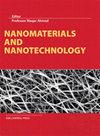Characteristics and properties of nitrocellulose/glycidyl azide polymer/2,4,6,8,10,12-hexanitro-2,4,6,8,10,12-hexaazaisowurtzitane nanocomposites synthesized using a sol–gel supercritical method
IF 3.3
3区 材料科学
Q2 MATERIALS SCIENCE, MULTIDISCIPLINARY
引用次数: 8
Abstract
Nitrocellulose/glycidyl azide polymer/2,4,6,8,10,12-hexanitro-2,4,6,8,10,12-hexaazaisowurtzitane nanocomposites, in which 2,4,6,8,10,12-hexanitro-2,4,6,8,10,12-hexaazaisowurtzitane nanoparticles uniformly embedded in nitrocellulose/glycidyl azide polymer matrix, were synthesized using a sol–gel supercritical method. The micron morphology, crystal phase, molecular structure, specific surface area, and surface elements were characterized using scanning electron microscopy, X-ray diffractometry, infrared, Brunauer–Emmett–Teller, and X-ray photoelectron spectroscopy analyses, respectively. Thermal analyses were performed, and the kinetic and thermodynamic parameters, such as activation energy, per-exponent factor, rate constant, activation heat, activation free energy, and activation entropy, were calculated. The decomposition products of the nitrocellulose/glycidyl azide polymer matrix and nitrocellulose/glycidyl azide polymer/2,4,6,8,10,12-hexanitro-2,4,6,8,10,12-hexaazaisowurtzitane were also investigated by differential scanning calorimetry–infrared analysis. The result indicated that the main decomposition product of nitrocellulose/glycidyl azide polymer is carbon dioxide and the –N3 group in glycidyl azide polymer decomposed to nitrogen without being detected by infrared spectrometer; the main decomposition products of nitrocellulose/glycidyl azide polymer/2,4,6,8,10,12-hexanitro-2,4,6,8,10,12-hexaazaisowurtzitane are carbon dioxide, nitrous oxide, and water, and few carbon monoxide, methane, and nitrogen oxide are also detected. Energy performances of nitrocellulose/glycidyl azide polymer matrix and nitrocellulose/glycidyl azide polymer/2,4,6,8,10,12-hexanitro-2,4,6,8,10,12-hexaazaisowurtzitane nanocomposites were evaluated, that is, the parameters such as standard specific impulse, characteristic speed, combustion chamber temperature, average molecular weight of combustion products, and explosion heat were calculated. The results illustrated that as the weight percentage of nitrocellulose increases, the values of standard specific impulse, characteristic speed, average molecular weight of combustion products, combustion chamber temperature, and explosion heat increase. This was ascribed to that the oxygen balance of glycidyl azide polymer is substantially lower than that of nitrocellulose, which results in that the chemical energy of glycidyl azide polymer does not release sufficiently. Additionally, as weight percentage of glycidyl azide polymer increases, the impact and friction sensitivity of the composites decrease obviously. This means that glycidyl azide polymer is much more insensitive than nitrocellulose.溶胶-凝胶超临界法合成硝化纤维素/叠氮缩水甘油酯聚合物/2,4,6,8,10,12-六硝基-2,4,6,80,12-六氮杂异纤锌烷纳米复合材料的特性与性能
采用溶胶-凝胶超临界方法合成了硝基纤维素/叠氮缩水甘油酯聚合物/2,4,6,8,10,12-六硝基-2,4,6,80,12-六氮杂异纤锌烷纳米复合材料,其中2,4,6,8,10,2-六硝基-2,4,6,,8,10,10-六氮杂异纤锌烷纳米粒子均匀包埋在硝基纤维素/迭氮缩水甘油醚聚合物基体中。分别使用扫描电子显微镜、X射线衍射仪、红外、Brunauer–Emmett–Teller和X射线光电子能谱分析对微米形态、晶相、分子结构、比表面积和表面元素进行了表征。进行了热分析,计算了活化能、每指数因子、速率常数、活化热、活化自由能和活化熵等动力学和热力学参数。通过差示扫描量热-红外分析研究了硝化纤维素/叠氮缩水甘油酯聚合物基体和硝化纤维素/迭氮缩水甘油醚聚合物/2,4,6,8,10,12-六硝基-2,4,6,80,12-六氮杂异纤锌烷的分解产物。结果表明,硝化纤维素/叠氮缩水甘油酯聚合物的主要分解产物是二氧化碳,叠氮缩水缩水甘油酯中的–N3基团在红外光谱仪未检测到的情况下分解为氮气;硝化纤维素/叠氮缩水甘油酯聚合物/2,4,6,8,10,12-六硝基-2,4,6,80,12-六氮杂异纤锌烷的主要分解产物为二氧化碳、一氧化二氮和水,同时检测到少量一氧化碳、甲烷和氮氧化物。对硝基纤维素/叠氮缩水甘油酯聚合物基体和硝基纤维素/迭氮缩水甘油醚聚合物/2,4,6,8,10,12-六硝基-2,4,6,80,10,12-六氮杂异纤锌烷纳米复合材料的能量性能进行了评价,即计算了标准比冲、特征速度、燃烧室温度、燃烧产物平均分子量和爆炸热等参数。结果表明,随着硝化纤维重量百分比的增加,标准比冲、特征速度、燃烧产物的平均分子量、燃烧室温度和爆炸热的值都会增加。这归因于叠氮缩水甘油酯聚合物的氧平衡显著低于硝化纤维素的氧平衡,这导致叠氮缩水缩水甘油酯的化学能不能充分释放。此外,随着叠氮缩水甘油酯聚合物重量百分比的增加,复合材料的冲击和摩擦敏感性明显降低。这意味着叠氮缩水甘油酯聚合物比硝化纤维素更不敏感。
本文章由计算机程序翻译,如有差异,请以英文原文为准。
求助全文
约1分钟内获得全文
求助全文
来源期刊

Nanomaterials and Nanotechnology
NANOSCIENCE & NANOTECHNOLOGY-MATERIALS SCIENCE, MULTIDISCIPLINARY
CiteScore
7.20
自引率
21.60%
发文量
13
审稿时长
15 weeks
期刊介绍:
Nanomaterials and Nanotechnology is a JCR ranked, peer-reviewed open access journal addressed to a cross-disciplinary readership including scientists, researchers and professionals in both academia and industry with an interest in nanoscience and nanotechnology. The scope comprises (but is not limited to) the fundamental aspects and applications of nanoscience and nanotechnology
 求助内容:
求助内容: 应助结果提醒方式:
应助结果提醒方式:


